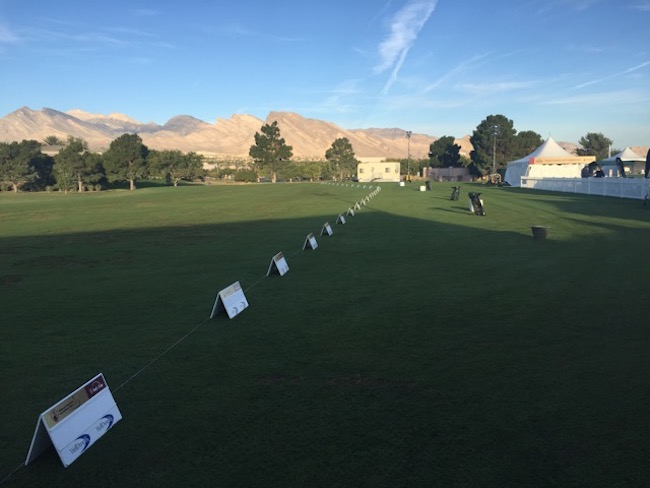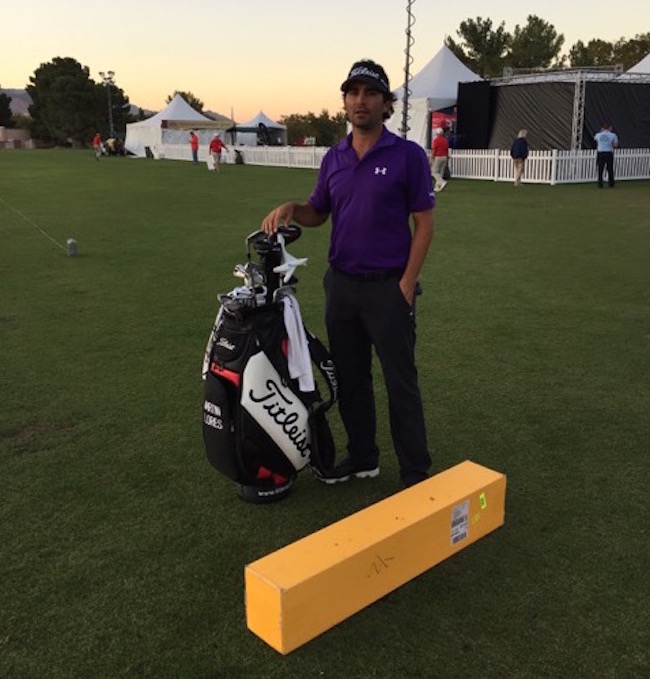Opinion & Analysis
18 Stats and Stories from Live at the Shriners Open

When the opportunity arose to report in person from this year’s Shriners Hospitals for Children Open in Las Vegas, I didn’t hesitate to go all-in.
Arriving on Monday, I spent the week under brilliant blue skies on the immaculate grounds of TPC Summerlin, where, as it turned out, the field showcased a larger number of promising youngsters than usual, along with seasoned pros, including the eventual winner.
What follows is a selection of stories and statistics that made an impression on me during a lucky golfer’s week at the Tour’s fabulous Sin City stop.
1) Jerty Bird, from inside the ropes
Nothing much more fun than strolling the fairways in a @PGATOUR event – it’s way cooler than imagined.
— Marty Jertson (@jertybird) November 3, 2016
Jertson, who is Senior Design Engineer at Ping, earned his Vegas spot by winning sectional qualifying. His Thursday round was definitely not a good stroll spoiled: on his way to a 1-under 70, Jertson was the only player to hit every green in regulation — he does, after all, play clubs that he helped create. Unfortunately, @jertybird came back down to earth on Friday, still hitting three out of four greens, but shooting 1-over par and missing the cut by three at even par.
See the clubs Jerston had in the bag this week.
2) The 2016 PGA Champion struggles, to say the least
With an Official World Golf Ranking of 18, Jimmy Walker was the highest ranked player in the Shriners field. Unfortunately, he didn’t play like it. His 8-over par, 74-76 missed the cut by eleven, just two shots better than the worst score posted. Over his final 27 holes, Walker managed only two birdies. Which isn’t surprising, in light of a couple of other rankings: 129th in strokes gained putting, 132nd in total putting, and 139th (dead last) in strokes gained off the tee.
3) The big hitter
Longest drive of the week: 370 yards (Ryan Brehm, 13th hole, fourth round). Beast.
4) An over-sized field: The lucky ones
The Shriners field was to consist of 132 players; a mix-up resulted in there being 144. How many of the Lucky Twelve opened the door when opportunity knocked?
Eight, including most notably of course the winner, Rod Pampling, who followed a course-record 60 on Thursday with rounds of 68, 71, and 65. The other seven who made the cut: Ryan Blaum, (10-under, T31); Trey Mullinax, (9-under, T36); Will MacKenzie, (7-under, T48); Gonzalo Fernandez-Castano, (7-under, T48); C.T. Pan, (5-under, T57); Seamus Power, (5-under, T57); and Mackenzie Hughes, (2-under, T68).
5) A victim and a survivor

Early morning on the range: The calm before the storm
As a result of the super-sized field, play was suspended because of darkness in both the first and second rounds. Among those affected by the latter interruption were Kevin Tway and Ryan Brehm, each with several holes to go. When the re-start horn sounded at 7:30 a.m. on Saturday, Tway was on the green, and Brehm was on the tee. It was a gorgeous desert morning, with the just-risen sun casting long shadows. But other than a few tournament workers and a single spectator, players and caddies were on their own.
Tway’s first stroke at the crack of dawn was with his putter: from 38 feet, he rolled it 10 feet past. Something about the silence and the lack of a crowd made Tway’s comebacker seemed more nerve-racking than a putt I’ve ever faced.
Meanwhile, Brehm had driven it 276 yards onto a slope of desert waste ground. To hit his second, he had to get entirely too intimate with a scraggly bush. Brehm managed to advance the ball, but only a couple of yards, and still in the rocky scrub. Extricating himself from his new best friend, Brehm held the club across his belly, gripped in both hands, as if tempted to snap the thing in half.
Tway did make his tester, but it wasn’t enough to salvage the round, ultimately shooting 1-over. Tway finished 36 holes at 2-under, missing the cut by one. Brehm ended up double-bogeying the sixth, which left him just one above the then projected cut-line. But he rallied with birdies on two of his final three re-start holes, and shortly thereafter headed right back out, into the decidedly more glamorous atmosphere of Moving Day proper. He’d go on to post a 67, and sat in T21 at event’s end.
6) Henley closes hot
Low round on Moving Day belonged to Russell Henley: a bogey-free 63. Heading into Sunday, the two-time Tour winner had gone 30 holes without a bogey. He has form when it comes to moving and then closing hot: at Sanderson Farms, where he finished T14 at 11-under, he had eleven birdies and just one bogey over the final 51 holes.
7) The youngster
Twenty-year-old Aaron Wise was the youngest Shriners Open entrant, making his fifth career PGA Tour start as a sponsor invite. The 2016 NCAA individual medalist while at Oregon, Wise will be on the Web.com Tour in 2017.
Wise’s coach, Jeff Smith of TPC Summerlin, has described Wise as “one of the straightest drivers I have ever seen when he wants to be. His ability to drive the golf ball is what sets him apart.”
Related: See the clubs Wise has in the bag in 2016
At the Shriners, however, Wise couldn’t find the fairway at first: he was T132 in Driving Accuracy after the first round (only 4 of 14 fairways), and still struggling through the second. That evening, he was the last man on the range under the lights, driver in hand and working, as he explained to me, on losing the push-cut and keeping the clubface from “getting right” on him. Result? In Round 3, Wise climbed to T1 in the same category, hitting 11 of 14 fairways.
Wise shot 68 Sunday, finishing T10 at 14-under. But the driver troubles had returned: he hit only 4 of 14 again, and dropped back to last (T72) in terms of closing-day Driving Accuracy.
8) The best scramblers
- Best scrambling percentage: 78.26 percent (Vaughan Taylor, making 18 saves on 23 missed greens in regulation).
- Best sand save percentage: 100 percent (Seung-Yul Noh, 4 for 4; Sean O’Hair, 3 for 3).
- Most bunkers hit into: 12 (Ernie Els, who made 6 saves), 11 (Keegan Bradley, who made 8).
9) The best putters
- Fewest putts per round: 21 (Chez Reavie, round 2).
- Best percentage on putts from outside 25-feet: 27.8 percent (Brian Gay, 5 out of 18).
- Best one-putt percentage: 56.94 percent (Michael Kim, with 41 one-putts over the seventy-two holes).
10) Fez wearers, fundraisers and a great swing

Within two club-lengths of just about everywhere you go at the Shriners, you catch sight of a fez. It has got to be the most distinctive headgear encountered on the PGA Tour. Worn by higher-ups in the Shriners — including “Potentates” — each fez is embroidered with the arabian-themed name of the wearer’s home course, by which I mean his local chapter, known as a “temple.” For example, in the accompanying photo, Richard Burke, Jeff Sowder, and Kevin Costello represent for Atlanta’s “Yaarab,” Wichita’s “Midian,” and Albany’s “Cyprus.”
What a golf swing.
Tommy Morrissey, 5, hit the ceremonial first tee shot today @ShrinersOpen. https://t.co/7JU1ieGzoD
— PGA TOUR (@PGATOUR) November 3, 2016
It should be noted what outstanding charitable work the Shriners do through their Hospitals for Children. At 22 locations, they provide life-changing care for kids, regardless of their families’ ability to pay. One of their patients, 5-year-old Tommy Morrissey, dazzled a number of hard-to-impress Tour pros early in the week with his unique golfing skill. For more about Tommy and the Shriners: @onearmgolfer and www.shrinershospitalsforchildren.org.
11) A fruitful late-night range session

Martin Flores was spotted as the last player on the range after he moved the wrong way on Moving Day, following up back-to-back 67s, which included a total of 13 birdies, with a birdie-less 77 (the day’s worst round), leaving him T68 at 2-under. The rest of the field bagged 304 birds on Saturday; only Kevin Streelman joined Flores without a single circle on his card.
He must have found something on the range Saturday night, because he finished with a Sunday 65, good for T41. From 77 to 65 in just one day; isn’t golf a crazy game?
The Shriners is Flores’ third event of 2016-17, and the second cut he’s made. He re-earned his Tour card for this season with an outstanding ’15-’16 on the Web.com Tour, where he had a win plus seven top-10s in 21 starts.
12) The most difficult hole
The 492-yard, par-4 third, which played to a 4.27 scoring average, allowing only 33 birdies, compared to 120 bogeys and 17 doubles or worse. Winner Rod Pampling played the hole in 2-under for the week, making birdie, birdie, par, par.
13) The easiest hole
The 560-yard, par-5 16th, which played to a 4.14 scoring average, as the field notched 32 eagles and 231 birdies, versus only 27 bogeys and 3 doubles or worse.
14) Perez changes clubs, gets his swagger back

Pat Perez had the kind of week (15-under, finishing T7) that prompted questions about how it felt to have his “swagger” back. Biggest factor: he’s healthy again. But he’s also switched to some new clubs, as he explained to ASAP Sports, “and I got a lot longer once I was healthy.” He added: “I’m actually hitting it solid, so much farther than I used to, and I’m in places that I have never been on this course. I hit 7-iron into 16 today and made eagle. I’ve never had anything less than hybrid in there.”
See the clubs Perez used at the Shriners Open here.
15) “Other,” the worst word in golf
In golf, there are eagles, birdies, pars, bogeys, double-bogeys … and “other.” Ah yes, the dreaded other. At the Shriners, there were 26 of them (as against 61 eagles and 4,685 pars), and one other belonged to defending Shriners champion Smylie Kaufman. His third-round snowman at the par-4 sixth hole resulted from first having trouble off the tee, and then trying to get back out of that trouble. Plus — wait for it, all of you who, like me, know all too well how this particular tune goes — three putts from 20 feet.
16) The drama
Sunday’s final group consisted of Lucas Glover, Rod Pampling and Brooks Koepka, with Glover in the lead by one at 15-under. After the trio started with pars, there was lead-altering action on virtually every hole. Glover and Koepka birdied two. Glover bogeyed three. Birdies all-round on four. Koepka bogeyed five. Pampling birdied six. Pars all round on seven. Pampling birdied eight, then he and Glover birdied nine.
At the turn: Pampling (18-under); Glover, (17-under); Koepka, (15 -under), and four other players had also reached 15-under by then.
Pampling bogeyed 10. Glover bogeyed 11, then birdied 12, while Pampling bogeyed 12. Koepka’s par-streak, meantime, had reached seven at this point. It didn’t reach eight: Kopeka birdied 13, as did Pampling and Lucas. Pampling birdied 14. My head was starting to spin.
So, with four to go: Pampling (18-under); Glover, (18-under); Koepka, 16 (16-under). Molinari was in the clubhouse at 16-under, with Oglivy, in the last-but-one group, now at that number too. Birdies all-round at 15 for the final group. Koepka birdied 16. Glover bogeyed 17. This is getting interesting.
One to go: Pampling (19-under); Glover, (18-under); Koepka, (18-under). And Pampling drives the nail into the coffin by absolutely burying a 32-footer to close out with a birdie. Koepka finished second with a par and two shots back, while Glover finished third with a closing-hole bogey.
Related: What Pampling was thinking over his winning putt
In all, 26 birdies and bogeys were made by the final group. Talk about excitement!
17) Pampling earned it
Rod Pampling made a combined 325-feet and 4-inches of putts on his way to the win. He ranked first in total strokes gained, in strokes gained around the green, and in strokes gained tee-to-green. He was T15 in driving accuracy, and hit 56 of 72 greens in regulation (T11).
18) Sunday Scorecard
- Francesco Molinari’s Sunday 61 started taking shape when he holed-out from 124 yards for eagle at the 440-yard 11th hole (he started on the back). Molinari added eight birdies in his bogey-free round, and had the clubhouse lead at 16-under 268, where he was later joined by Harris English and Geoff Ogilvy for a T4 finish.
- Keegan Bradley’s strong season continued, closing with a 66 to finish T7 at 15-under.
- Kevin Streelman got right back on the birdie train on Sunday, sinking a 5-footer on the 10th hole, his opening hole.
- Martin Flores had to wait to re-board that train until his sixth hole of the day, after starting out with five pars. He then added more birdies on his seventh, ninth, 10th, 16th and 18th. Flores’ line: 67, 67, 77, 65, for an 8-under 276 and a T41 finish. He also drove long all week, averaging 307 yards, second in the field.
- Russell Henley never got it going. He bogeyed number five, after opening with four straight pars, then also bogeyed nine and 16. Posting only a pair of birdies, he finished with a 72, for T24 at 12-under.
- LIKE12
- LEGIT1
- WOW2
- LOL0
- IDHT0
- FLOP0
- OB0
- SHANK1
19th Hole
Vincenzi’s 2024 Zurich Classic of New Orleans betting preview

The PGA TOUR heads to New Orleans to play the 2023 Zurich Classic of New Orleans. In a welcome change from the usual stroke play, the Zurich Classic is a team event. On Thursday and Saturday, the teams play best ball, and on Friday and Sunday the teams play alternate shot.
TPC Louisiana is a par 72 that measures 7,425 yards. The course features some short par 4s and plenty of water and bunkers, which makes for a lot of exciting risk/reward scenarios for competitors. Pete Dye designed the course in 2004 specifically for the Zurich Classic, although the event didn’t make its debut until 2007 because of Hurricane Katrina.
Coming off of the Masters and a signature event in consecutive weeks, the field this week is a step down, and understandably so. Many of the world’s top players will be using this time to rest after a busy stretch.
However, there are some interesting teams this season with some stars making surprise appearances in the team event. Some notable teams include Patrick Cantlay and Xander Schauffele, Rory McIlroy and Shane Lowry, Collin Morikawa and Kurt Kitayama, Will Zalatoris and Sahith Theegala as well as a few Canadian teams, Nick Taylor and Adam Hadwin and Taylor Pendrith and Corey Conners.
Past Winners at TPC Louisiana
- 2023: Riley/Hardy (-30)
- 2022: Cantlay/Schauffele (-29)
- 2021: Leishman/Smith (-20)
- 2019: Palmer/Rahm (-26)
- 2018: Horschel/Piercy (-22)
- 2017: Blixt/Smith (-27)
2024 Zurich Classic of New Orleans Picks
Tom Hoge/Maverick McNealy +2500 (DraftKings)
Tom Hoge is coming off of a solid T18 finish at the RBC Heritage and finished T13 at last year’s Zurich Classic alongside Harris English.
This season, Hoge is having one of his best years on Tour in terms of Strokes Gained: Approach. In his last 24 rounds, the only player to top him on the category is Scottie Scheffler. Hoge has been solid on Pete Dye designs, ranking 28th in the field over his past 36 rounds.
McNealy is also having a solid season. He’s finished T6 at the Waste Management Phoenix Open and T9 at the PLAYERS Championship. He recently started working with world renowned swing coach, Butch Harmon, and its seemingly paid dividends in 2024.
Keith Mitchell/Joel Dahmen +4000 (DraftKings)
Keith Mitchell is having a fantastic season, finishing in the top-20 of five of his past seven starts on Tour. Most recently, Mitchell finished T14 at the Valero Texas Open and gained a whopping 6.0 strokes off the tee. He finished 6th at last year’s Zurich Classic.
Joel Dahmen is having a resurgent year and has been dialed in with his irons. He also has a T11 finish at the PLAYERS Championship at TPC Sawgrass which is another Pete Dye track. With Mitchell’s length and Dahmen’s ability to put it close with his short irons, the Mitchell/Dahmen combination will be dangerous this week.
Taylor Moore/Matt NeSmith +6500 (DraftKings)
Taylor Moore has quickly developed into one of the more consistent players on Tour. He’s finished in the top-20 in three of his past four starts, including a very impressive showing at The Masters, finishing T20. He’s also finished T4 at this event in consecutive seasons alongside Matt NeSmith.
NeSmith isn’t having a great 2024, but has seemed to elevate his game in this format. He finished T26 at Pete Dye’s TPC Sawgrass, which gives the 30-year-old something to build off of. NeSmith is also a great putter on Bermudagrass, which could help elevate Moore’s ball striking prowess.
- LIKE8
- LEGIT3
- WOW1
- LOL1
- IDHT0
- FLOP3
- OB1
- SHANK1
19th Hole
Vincenzi’s 2024 LIV Adelaide betting preview: Cam Smith ready for big week down under

After having four of the top twelve players on the leaderboard at The Masters, LIV Golf is set for their fifth event of the season: LIV Adelaide.
For both LIV fans and golf fans in Australia, LIV Adelaide is one of the most anticipated events of the year. With 35,000 people expected to attend each day of the tournament, the Grange Golf Club will be crawling with fans who are passionate about the sport of golf. The 12th hole, better known as “the watering hole”, is sure to have the rowdiest of the fans cheering after a long day of drinking some Leishman Lager.
The Grange Golf Club is a par-72 that measures 6,946 yards. The course features minimal resistance, as golfers went extremely low last season. In 2023, Talor Gooch shot consecutive rounds of 62 on Thursday and Friday, giving himself a gigantic cushion heading into championship Sunday. Things got tight for a while, but in the end, the Oklahoma State product was able to hold off The Crushers’ Anirban Lahiri for a three-shot victory.
The Four Aces won the team competition with the Range Goats finishing second.
*All Images Courtesy of LIV Golf*
Past Winners at LIV Adelaide
- 2023: Talor Gooch (-19)
Stat Leaders Through LIV Miami
Green in Regulation
- Richard Bland
- Jon Rahm
- Paul Casey
Fairways Hit
- Abraham Ancer
- Graeme McDowell
- Henrik Stenson
Driving Distance
- Bryson DeChambeau
- Joaquin Niemann
- Dean Burmester
Putting
- Cameron Smith
- Louis Oosthuizen
- Matt Jones
2024 LIV Adelaide Picks
Cameron Smith +1400 (DraftKings)
When I pulled up the odds for LIV Adelaide, I was more than a little surprised to see multiple golfers listed ahead of Cameron Smith on the betting board. A few starts ago, Cam finished runner-up at LIV Hong Kong, which is a golf course that absolutely suits his eye. Augusta National in another course that Smith could roll out of bed and finish in the top-ten at, and he did so two weeks ago at The Masters, finishing T6.
At Augusta, he gained strokes on the field on approach, off the tee (slightly), and of course, around the green and putting. Smith able to get in the mix at a major championship despite coming into the week feeling under the weather tells me that his game is once again rounding into form.
The Grange Golf Club is another course that undoubtedly suits the Australian. Smith is obviously incredibly comfortable playing in front of the Aussie faithful and has won three Australian PGA Championship’s. The course is very short and will allow Smith to play conservative off the tee, mitigating his most glaring weakness. With birdies available all over the golf course, there’s a chance the event turns into a putting contest, and there’s no one on the planet I’d rather have in one of those than Cam Smith.

Louis Oosthuizen +2200 (DraftKings)
Louis Oosthuizen has simply been one of the best players on LIV in the 2024 seas0n. The South African has finished in the top-10 on the LIV leaderboard in three of his five starts, with his best coming in Jeddah, where he finished T2. Perhaps more impressively, Oosthuizen finished T7 at LIV Miami, which took place at Doral’s “Blue Monster”, an absolutely massive golf course. Given that Louis is on the shorter side in terms of distance off the tee, his ability to play well in Miami shows how dialed he is with the irons this season.
In addition to the LIV finishes, Oosthuizen won back-to-back starts on the DP World Tour in December at the Alfred Dunhill Championship and the Mauritus Open. He also finished runner-up at the end of February in the International Series Oman. The 41-year-old has been one of the most consistent performers of 2024, regardless of tour.
For the season, Louis ranks 4th on LIV in birdies made, T9 in fairways hit and first in putting. He ranks 32nd in driving distance, but that won’t be an issue at this short course. Last season, he finished T11 at the event, but was in decent position going into the final round but fell back after shooting 70 while the rest of the field went low. This season, Oosthuizen comes into the event in peak form, and the course should be a perfect fit for his smooth swing and hot putter this week.

- LIKE12
- LEGIT3
- WOW1
- LOL1
- IDHT0
- FLOP1
- OB1
- SHANK1
Opinion & Analysis
The Wedge Guy: What really makes a wedge work? Part 1

Of all the clubs in our bags, wedges are almost always the simplest in construction and, therefore, the easiest to analyze what might make one work differently from another if you know what to look for.
Wedges are a lot less mysterious than drivers, of course, as the major brands are working with a lot of “pixie dust” inside these modern marvels. That’s carrying over more to irons now, with so many new models featuring internal multi-material technologies, and almost all of them having a “badge” or insert in the back to allow more complex graphics while hiding the actual distribution of mass.
But when it comes to wedges, most on the market today are still single pieces of molded steel, either cast or forged into that shape. So, if you look closely at where the mass is distributed, it’s pretty clear how that wedge is going to perform.
To start, because of their wider soles, the majority of the mass of almost any wedge is along the bottom third of the clubhead. So, the best wedge shots are always those hit between the 2nd and 5th grooves so that more mass is directly behind that impact. Elite tour professionals practice incessantly to learn to do that consistently, wearing out a spot about the size of a penny right there. If impact moves higher than that, the face is dramatically thinner, so smash factor is compromised significantly, which reduces the overall distance the ball will fly.
Every one of us, tour players included, knows that maddening shot that we feel a bit high on the face and it doesn’t go anywhere, it’s not your fault.
If your wedges show a wear pattern the size of a silver dollar, and centered above the 3rd or 4th groove, you are not getting anywhere near the same performance from shot to shot. Robot testing proves impact even two to three grooves higher in the face can cause distance loss of up to 35 to 55 feet with modern ‘tour design’ wedges.
In addition, as impact moves above the center of mass, the golf club principle of gear effect causes the ball to fly higher with less spin. Think of modern drivers for a minute. The “holy grail” of driving is high launch and low spin, and the driver engineers are pulling out all stops to get the mass as low in the clubhead as possible to optimize this combination.
Where is all the mass in your wedges? Low. So, disregarding the higher lofts, wedges “want” to launch the ball high with low spin – exactly the opposite of what good wedge play requires penetrating ball flight with high spin.
While almost all major brand wedges have begun putting a tiny bit more thickness in the top portion of the clubhead, conventional and modern ‘tour design’ wedges perform pretty much like they always have. Elite players learn to hit those crisp, spinny penetrating wedge shots by spending lots of practice time learning to consistently make contact low in the face.
So, what about grooves and face texture?
Grooves on any club can only do so much, and no one has any material advantage here. The USGA tightly defines what we manufacturers can do with grooves and face texture, and modern manufacturing techniques allow all of us to push those limits ever closer. And we all do. End of story.
Then there’s the topic of bounce and grinds, the most complex and confusing part of the wedge formula. Many top brands offer a complex array of sole configurations, all of them admittedly specialized to a particular kind of lie or turf conditions, and/or a particular divot pattern.
But if you don’t play the same turf all the time, and make the same size divot on every swing, how would you ever figure this out?
The only way is to take any wedge you are considering and play it a few rounds, hitting all the shots you face and observing the results. There’s simply no other way.
So, hopefully this will inspire a lively conversation in our comments section, and I’ll chime in to answer any questions you might have.
And next week, I’ll dive into the rest of the wedge formula. Yes, shafts, grips and specifications are essential, too.
- LIKE34
- LEGIT7
- WOW1
- LOL1
- IDHT2
- FLOP3
- OB1
- SHANK3
-

 19th Hole2 weeks ago
19th Hole2 weeks agoDave Portnoy places monstrous outright bet for the 2024 Masters
-

 19th Hole3 days ago
19th Hole3 days agoJustin Thomas on the equipment choice of Scottie Scheffler that he thinks is ‘weird’
-

 19th Hole2 weeks ago
19th Hole2 weeks agoTiger Woods arrives at 2024 Masters equipped with a putter that may surprise you
-

 19th Hole3 days ago
19th Hole3 days ago‘Absolutely crazy’ – Major champ lays into Patrick Cantlay over his decision on final hole of RBC Heritage
-

 19th Hole2 weeks ago
19th Hole2 weeks agoTwo star names reportedly blanked Jon Rahm all week at the Masters
-

 19th Hole1 week ago
19th Hole1 week agoReport: LIV Golf identifies latest star name they hope to sign to breakaway tour
-

 19th Hole1 week ago
19th Hole1 week agoNeal Shipley presser ends in awkward fashion after reporter claims Tiger handed him note on 8th fairway
-

 19th Hole1 week ago
19th Hole1 week agoBrandel Chamblee has ‘no doubt’ who started the McIlroy/LIV rumor and why

















robin
Nov 7, 2016 at 1:52 pm
what about Kyle Stanley! My favorite player his first top ten in quite sometime,so happy for him.